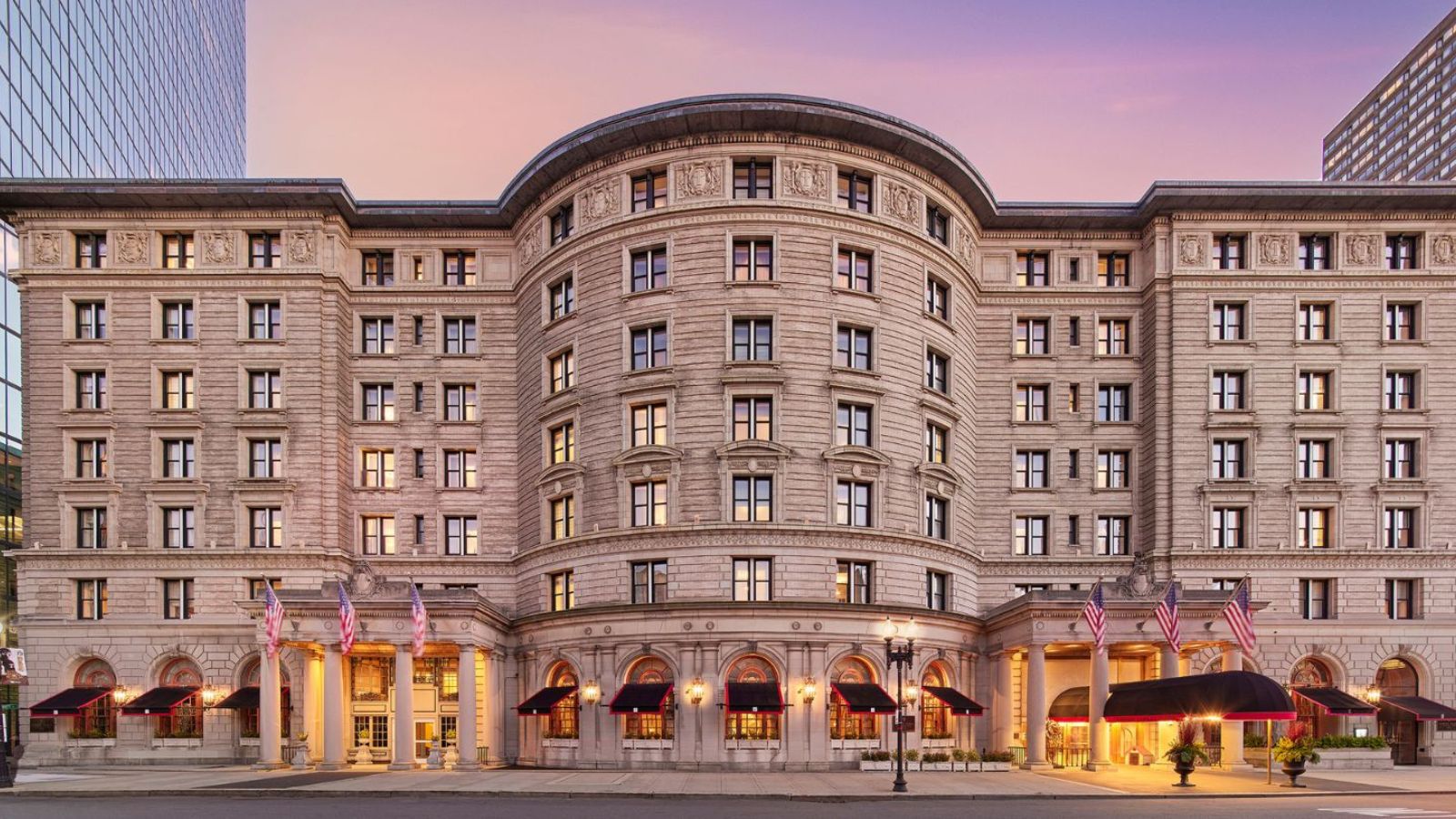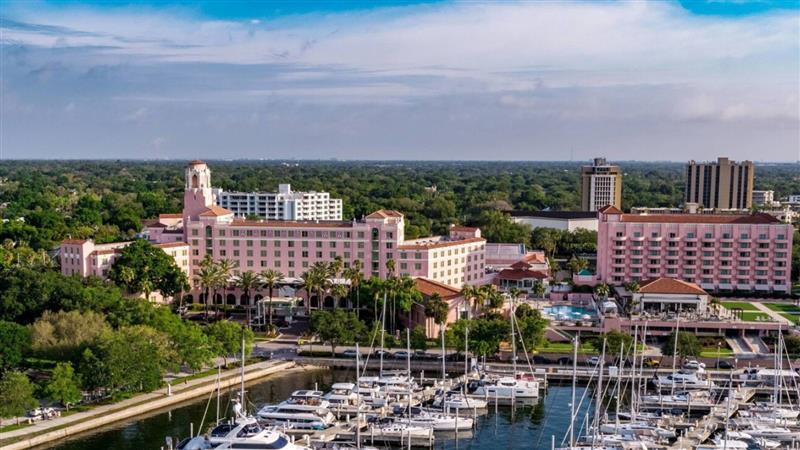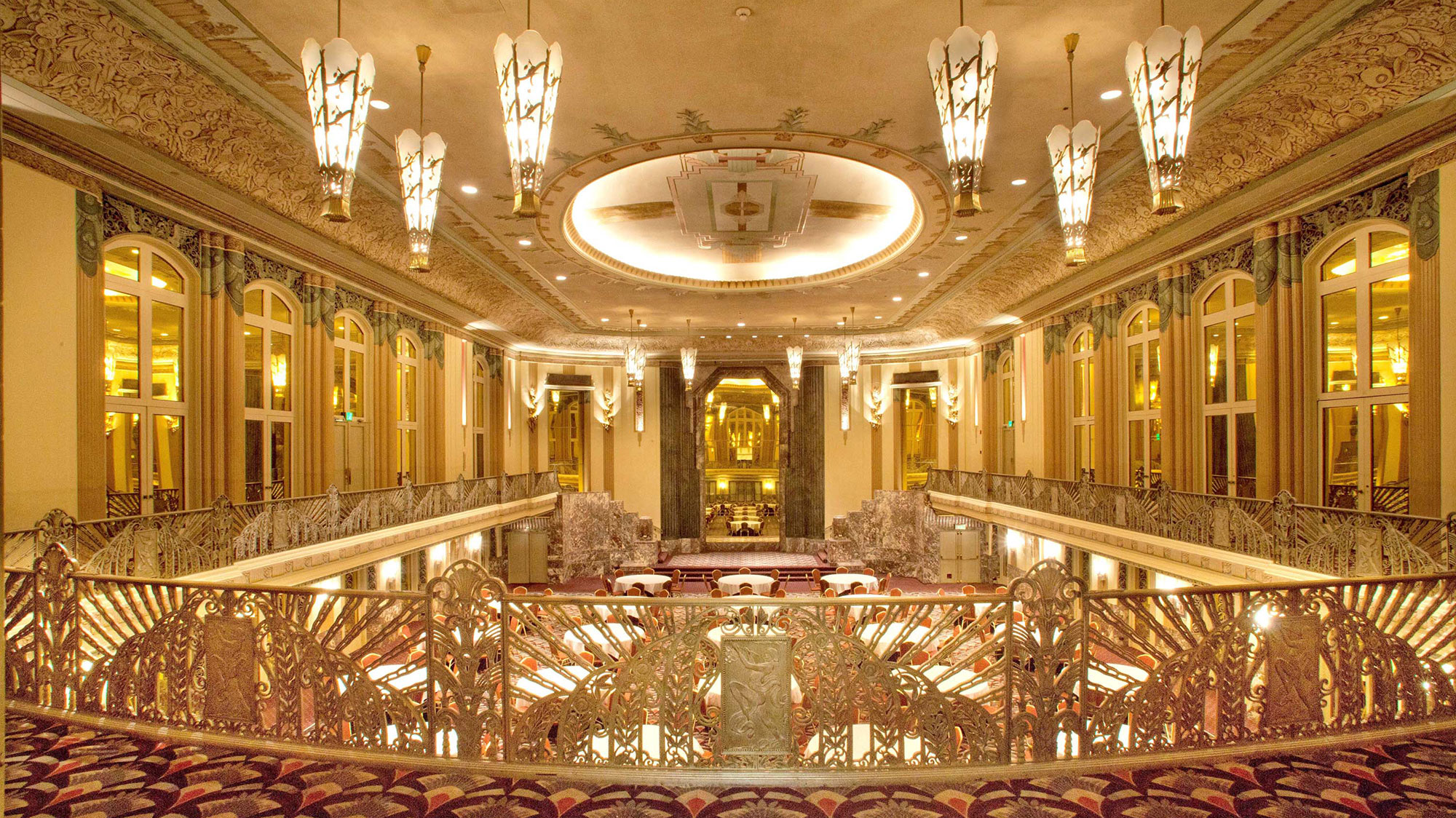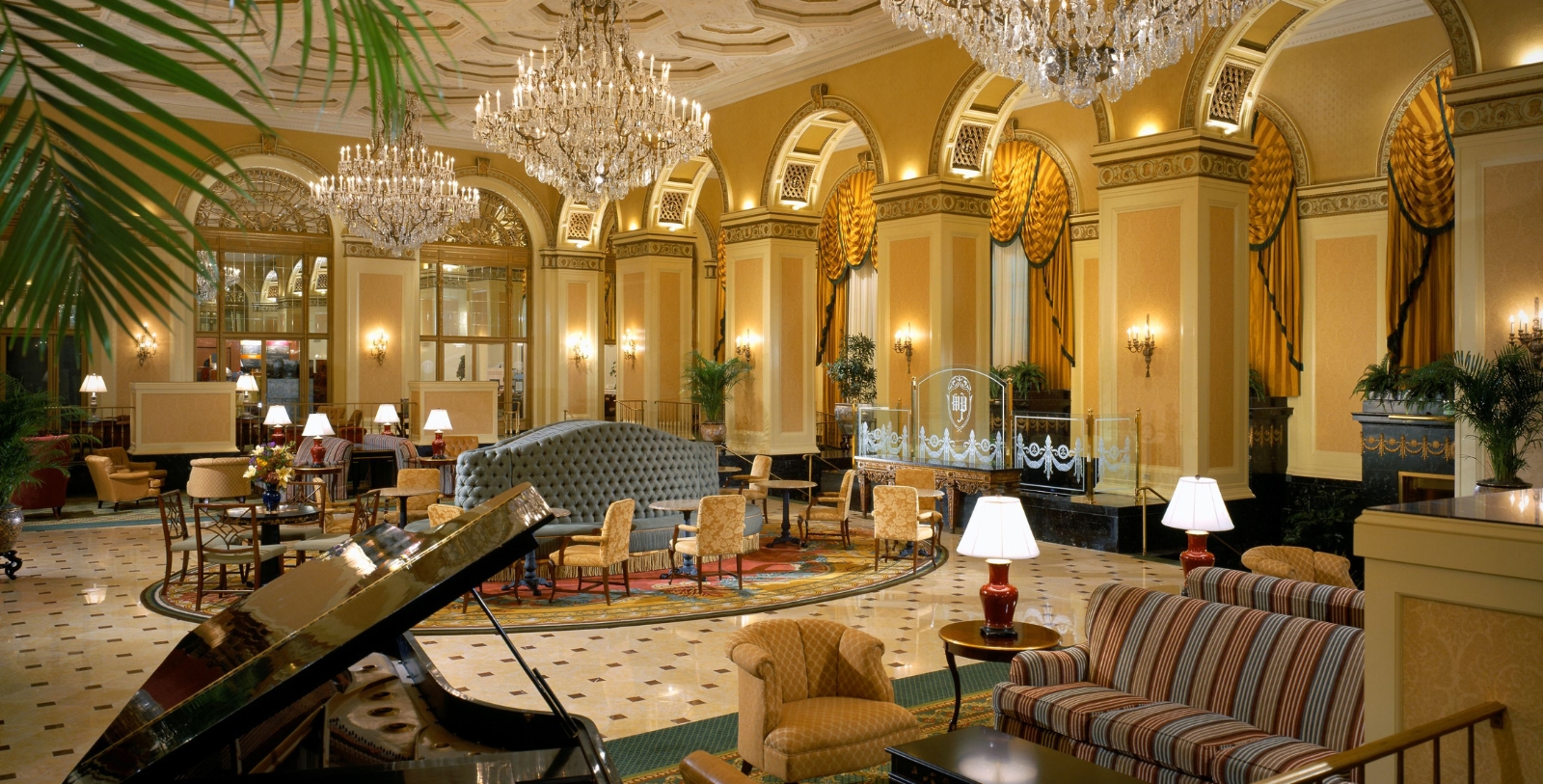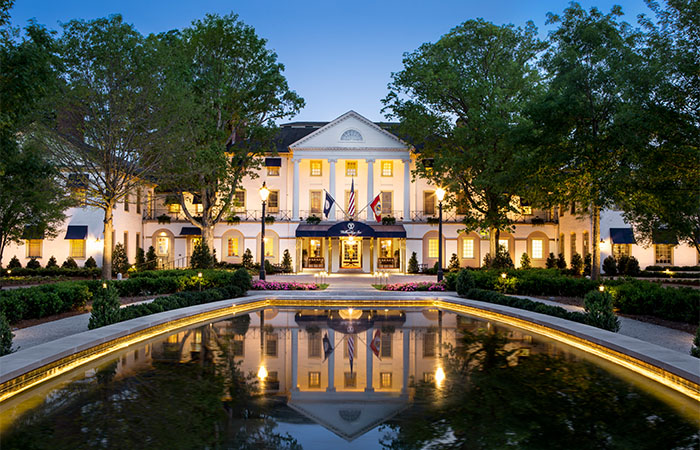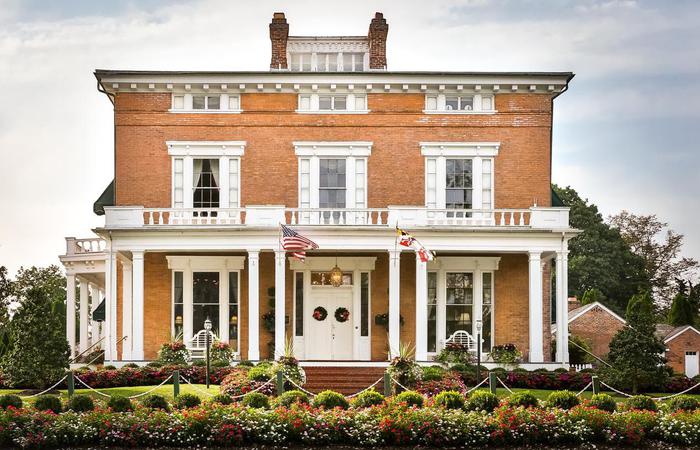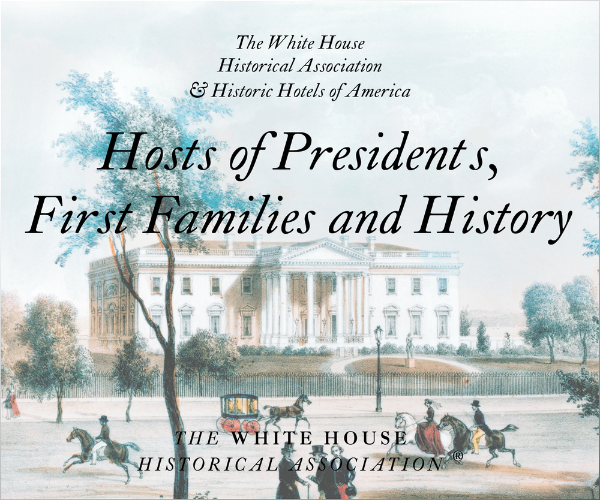Receive for Free - Discover & Explore eNewsletter monthly with advance notice of special offers, packages, and insider savings from 10% - 30% off Best Available Rates at selected hotels.
Guest Historian Series: Stanley Turkel, CMHS
Nobody Asked Me, But... No. 148;
Hotel History: The Plaza (1907), New York, New York*
By Stanley Turkel, CMHS
Originally constructed between 1905 and 1907, the Plaza Hotel is set back from Fifth Avenue and is prominently located near Grand Army Plaza and the Pulitzer Memorial Fountain. The 1969 New York Landmarks Designation Report said,
By day, the impressive white mass of the Plaza Hotel is visible above the trees in Central Park. By night, the lighted windows and the picturesque silhouette of the high roofs, reminiscent of a French Renaissance Chateau, add a note of beauty to the skyline… the building occupies one of the finest sites in the City and is the most elegant of our great New York hotels…. The boldness of mass and good scale of this eighteen story white brick and marble structure make the Plaza the outstanding example of American hotel architecture of the first decade of the Twentieth Century.
Eve Brown, in her book, The Plaza, Its Life and Times, says, “From the cotillion to the bunny hug, to the Charleston, to the frug; from diademed dowager to dancing deb; from Lillian Russell to Eloise; from Elinor Glyn to Eleanor Roosevelt; from Groucho to Gromyko; from Billie Burke to Brigitte Bardot; from Caruso to Ringo; from High Society to Hollywood – through all phases of transition, the Plaza has always managed to be in tune with the times, its dignity unruffled, its good taste unimpaired.”
The Plaza is the beneficiary of the work of three important early twentieth-century American architects:
• Henry J. Hardenbergh’s original design of 1905-1907
• Warren & Wetmore’s addition of the Fifth Avenue lobby and Terrace Room in 1919-1921
• Schultze & Weaver’s 1929 Grand Ballroom renovation
The Plaza has had numerous famous guests and performers and been the setting of many movies, including:
• F. Scott Fitzgerald, author of “The Great Gatsby”
• Cary Grant in “North by Northwest”
• Walter Matthau in “Plaza Suite”
• Barbra Streisand and Robert Redford in “The Way We Were”
• Clara Bow in “No Limit”
• “Barefoot in the Park”, “Crocodile Dundee”, “Home Alone 2”
• “Man on a String”, “40 Carats”, “Network”
• “The Front”, “The Rose”, “Love at First Bite”
• “Just Tell Me What You Want”, “Arthur”, “Prince of the City”
• “They All Laughed”, “Paternity”, “Author! Author!”
• “The Cotton Club”, “Unfaithfully Yours”, “Soapdish”
• “Brewster’s Millions”, “Big Business”, “The Pickle”
• “Scent of a Woman”, “Sleepless in Seattle”
• “It Could Happen to You”, “The Associate”
• “For Richer or Poorer”, “Gentleman’s Agreement”
Of all the show people who have been part of the Plaza’s history, only one has a permanent monument there. He’s an American theatrical icon named George M. Cohan, who was an actor, composer, playwright, producer, theater owner and a legend; the only person ever awarded the Congressional Medal of Honor for a song, the World War I favorite “Over There”. The Plaza is the only ten minutes away from Broadway and it was a convenient place for Cohan to unwind before the evening performance. From 4 p.m. to 7 p.m. each day, he had pre-theater cocktails in the Oak Room; his reserved table was a booth in the northwest corner. After he died in the early ‘40’s, the Lambs Club put a bronze placque on the wall above his booth which reads, “Here in this corner where he spent many happy hours, the Lambs have placed this tablet in honor of the most brilliant and versatile gentleman in the theatre of his day, George M. Cohan”. The Plaza, then owned by Conrad Hilton, officially named the Oak Room’s northwest corner, “The Cohan Corner”. In 1959, a statue of George M. Cohan was finally erected in Duffy Square on Broadway between 46th and 47th Streets- the same site that had earlier been proposed for General William Tecumsah Sherman’s monument which now stands in Grand Army Plaza opposite the Plaza Hotel.
For nearly 40 years, the Persian Room, a legendary nightclub at the Plaza, presented the most talented live performers. It opened on April 1, 1934, four months after the repeal of Prohibition, in the southern half of the Fifth Avenue dining room. It was designed in Art Deco style by the Viennese designer Joseph Urban, with murals by Lillian Gaertner Palmedo. Until it closed in 1975, the Persian Room featured such stars as Liberace, Carol Channing. Burl Ives, Eddy Duchin, Kitty Carlisle, the Mills Brothers, Bob Fosse, Victor Borge, Marge and Gower Champion, Eddie Fisher, Xavier Cugat, the McGuire Sisters, Dinah Shore, Vic Damone, Bob Hope, Robert Goulet, Frankie Laine, Ethel Merman, Eartha Kitt, Duke Ellington, Miles Davis, Billie Holiday and Hildegarde (record holder for most performances there).
In 1943, the Plaza was sold to Conrad Hilton for $7.4 million after 36 years of continuous original ownership by Harry S. Black, Bernhard Beineke and Fred Sterry. Hilton made important physical changes:
• Removed the brokerage firm of E. F. Hutton from its ground-floor parkside office (monthly rent: $416) and established it as the Oak Bar with continuing success
• Converted a basement storage area (once the Grill Room) into the Rendez-vous supper club
• Mezzanine writing rooms overlooking the lobby were converted into private meeting rooms
• Vitrines were installed throughout the lobby. When Conrad Hilton was told that the hotel could make $18,000 a year by renting a “vitrine” in the lobby corridor, Hilton said “I don’t know what a vitrine is, but if it will bring in eighteen thousand dollars, install it immediately.”
• The leaded-glass dome over the Palm Court was removed to allow for air conditioning equipment
Hilton sold the Plaza for $15 million in 1953 to the Boston industrialist A.M. Sonnabend, whose Hotel Corporation of America (HCA) focused on improving the operations. HCA bought professional management to the Plaza under some of the most famous General Managers in the industry: Neil Lang, Al Salomone, Jack Craver and George De Kornfeld. A.M. Sonnabend’s sons Roger and Paul, both Ivy League-educated, were the executives who revolutionized the hotel’s budgeting, advertising, leadership and human resource functions.
The Plaza was the hotel where the Beatles stayed when they came to the United States for their first appearance on the Ed Sullivan show. A few days before their arrival, one of the Plaza reservationists picked up the fact that G. Harrison, R. Starr, J. Lennon and P. McCartney had booked reservations. After their identification and arrival, the Plaza was overrun by hordes of teenage girls who found their way into the hotel’s fire stairways, in the front and back-of-the-house, a prospective public relations nightmare.
The Sonnabends developed a five-year strategic plan that identified the need for additional function space that was eventually installed on the second floor. They also created the famed Oyster Bar, in an underutilized area then occupied by the Hitchcock Gift Shop. They also operated other original restaurants including:
• Trader Vic’s
A branch of the legendary restaurant opened in the Savoy-Plaza Hotel in 1958 and moved to the Plaza in 1965 when the Savoy-Plaza was demolished. It replaced what was originally a Turkish Bath, and later the hotel barbershop in the Plaza’s basement. It closed in 1993 after serving Chinese and Japanese dishes and sweet rum drinks (including the mai tai cocktail) for twenty-eight years.
• Rendez-Vous
Adjacent to Trader Vic’s was the Rendez-Vous created by Serge Obolensky in October 1947 in the old Grill Room which was used for storage during the Depression. It was a gourmet’s delight with flaming swords of shashlik, crepes suzette and marrons flambés, an ice-sculptured tree laden with frozen oranges. Gypsy musicians alternated with a modern dance orchestra.
• Plaza 9
In the former Rendez-Vous, a little theater-type cabaret bearing the name “Plaza 9” was created for the sharp-edged comments of Julius Monk, a brilliant creator of satiric revues. A typical Monk skit depicted four Harvard professors, with a gleam in their eyes singing: “Don’t do the beguine, take mescaline, and the visions you’ll have are sure to be obscene.”
• Palm Court After 8
General Manager Alphonse Salomone transformed the Palm Court into “an enchanting continental setting” after 8PM with subtle lighting, a gold and white striped awning on the lobby windows, waitresses (for the first time) in Victorian costumes and soft background music. Clementine Paddleford, in her syndicated food column described it as the “most fashionable uptown coffeehouse in New York”.
In a stroke of advertising genius, James Lavenson, HCA’s Director of Marketing, devised a humorous advertising mail campaign to 30,000 business executives featuring a chatty chambermaid named Mary O’Sullivan (there was such a person). The ad copy drew a strong response; many businessmen wrote letters in kind and the hotel occupancy improved. But the Plaza’s greatest publicity bonanza (aside from having the Beatles as guests) began in 1955 when Kay Thompson published “Eloise”, all about an incorrigible 6-year-old who lives in the Plaza and does things such as ask room service for a raisin and seven spoons. Eloise became a world celebrity and her portrait adorns the Plaza lobby.
In 1969, the Landmarks Preservation Commission designated the Plaza Hotel as a landmark. Its designation report said:
The Plaza Hotel has had numerous well-known guests and its public rooms have held many notable events. Only a few days after the opening, Gladys Vanderbilt accepted Count Laslo Szechenyi’s marriage proposal in the Palm Court. In January 1908 Vanderbilt and Szechenyi, along with another engaged couple, Theodora Shonts and the Duc de Chaulnes, had tea in the Palm Court and attracted throngs of people who also wished to have tea. The New York Times reported: “at 4 o’clock crowds began to assemble in the hotel corridors and within a few minutes it was apparent that there was an unusual attraction. Within half an hour the corridors were impassable.” Over 3,000 people arrived to have tea, causing (General Manager) Sterry to open the men’s-only Edwardian Room and Grill Room in the basement. The Palm Court was immensely popular. The New York Times reported in 1909: “The Plaza is another of the hotels that has a large tea room [the Palm Court]. This has a capacity of 350. But here, as at the Waldorf, there is the same story of overflow into the main dining room. On an average 500 is the daily patronage, this number more than doubling on Saturdays. On these days, the main dining room and sometimes the breakfast room is given over to the tea drinkers. On a number of recent Saturdays the patronage swelled to such a volume that the management was on the point of commandeering the men’s café. By the early 1920s, the Tea Room was referred to as the Palm Room; it was officially renamed the Palm Court in the mid-1930s.
The Edwardian Room was first known as the Fifth Avenue Café, then the Plaza Restaurant in the 1940s before it was named the Edwardian Room in 1955. For its first 20 years, it was a men’s-only restaurant until the rule was relaxed in the 1930s. In 1971, it was named “The Green Tulip” and garishly redecorated. It took three years for management to mercifully restore it to its former elegance.
The Oak Room, originally the Men’s Bar, remained a bar until Prohibition, when the bar at the west end was removed and the room was used for storage.
Part of the 1940s restoration was the addition of three murals by the American painter Everett Shinn, a member of the “Ashcan School”, a turn-of-the-century movement to recreate a realistic cityscapes. Each time the hotel was sold after reopening of the Oak Bar, the Shinn paintings were not part of the sale and each successive owner had to negotiate separately for them. Westin Hotels negotiated for 14 months before actually buying them.
The Landmarks Designation Report continues:
Architect Frank Lloyd Wright, who always stayed at the Plaza when he was in New York, reportedly took credit for stopping a potentially disastrous renovation of the Oak Room and Edwardian Room. In the late 1940s the Oak Room was opened to women for supper but closed to them until 3 p.m. when the stock exchange closed. In August 1958 the Oak Bar played a supporting role in Alfred Hitchcock’s “North by Northwest”, in the scene where Cary Grant is abducted from the hotel. On February 12, 1969, the National Organization for Women staged a sit-in at the Oak Room to protest the lunch men-only policy. Betty Friedan, Diana Gartner and a third woman sat at a table and were refused service until 3 p.m. After picketing and negative publicity, the Plaza Hotel rescinded the men-only policy around four months later.
Schultze & Weaver redesigned the Grand Ballroom in 1929 so successfully that it became the premier place in New York to hold the most important and lavish celebrations, benefits, receptions and weddings. For example,
The Duke and Duchess of Windsor attended the December Ball, a benefit for disabled veterans, on December 11, 1946. Patricia Kennedy and Peter Lawford held their wedding reception in the Grand Ballroom on April 24, 1954. On December 8, 1959, Senator John F. and Jackie Kennedy attended the Wild West Ball benefiting the Kennedy family charity, the Kennedy Child Study Center for Retarded Children. The Grand Ballroom was the site of Truman Capote’s famous November 28, 1966 Black & White Costume Ball. Capote held his “little masked ball for Kay Graham and all my friends,” in honor of Katherine Graham, president of the Washington Post, and invited 540 people who were described “as spectacular a group as has ever been assembled for a private party in New York…” Guests included Frank Sinatra and Mia Farrow, Claudette Colbert, Lady Bird Johnson and Alice Roosevelt Longworth (President Theodore Roosevelt’s daughter). Men were asked to wear dinner jackets with black masks, while women were asked to wear black or white dresses and white masks. Capote stated: “I wanted it at The Plaza because I think it’s the only really beautiful ballroom left in the United States.” Shunning a White House wedding, Julie Nixon and David Eisenhower held their wedding reception in the ballroom on December 22, 1968.
On October 16, 1967, the City Club of New York sponsored one of its famous “Distinguished New Yorker” Award Dinners in the Plaza Grand Ballroom. The gala black-tie dinner honored the following (all of whom were present):
George Baehr
Martha Graham
Roger Baldwin
Alvin Johnson
Detlev Bronk
Robert Moses
Gordon Bunshaft
A. Philip Randolph
Cass Canfield
David Sarnoff
Richard Childs
Earl Schwulst
Kenneth Clark
Whitney North Seymour
Lou Crandall
Arthur Hays Sulzberger
Duke Ellington
Austin Tobin
It was a brilliant affair which was hosted by Stanley Turkel, Chairman of the Board of the City Club of New York. The featured speaker was John Kenneth Galbraith.
The Plaza was sold to Western International Hotels (later Westin) in 1975 for $25 million. Western had owned the 1,000-room Savoy-Plaza Hotel until it was demolished to make way for the General Motors Building on the east side of Fifth Avenue at 59th Street. Incidentally, the Savoy-Plaza was built in 1927 on the site of the old Savoy Hotel and was designed by McKim, Mead & White. In 1986, the Plaza was declared a National Historic Landmark.
In 1988, Donald Trump purchased the Plaza for $390 million. Trump said “I haven’t purchased a building, I have purchased a masterpiece- the Mona Lisa. For the first time in my life, I have made a deal that was not economic-for I can never justify the price I paid, no matter how successful the Plaza becomes.” With his then-wife Ivana (for the oft-quoted salary of “one dollar a year plus all the dresses she can buy”), he revitalized the hotel with careful renovation of the lobby, banquet rooms and certain suites.
In 1995, Trump sold the Plaza to Prince Alwalid bin Talal bin Abdulaziz Saud, partial owner of the Fairmont Hotels and CDL Hotels for $325 million.
The King of Morocco checked in with 1,269 pieces of luggage, rented the entire sixth floor and a section of the kitchen for his own chefs and cooks. A thick, strong incense odor lingered on the sixth floor long after the king and his entourage checked out. The King and Queen of Sweden arrived for a weekend with a mere 400 pieces of luggage.
While the exterior of the Plazas was designated a landmark in 1969, the New York Landmarks Preservation Commission in 2005 found that certain Plaza Hotel interiors “have a special character, special historical and aesthetic interest and value and… (are therefore) designated as an Interior Landmark.” This rare and unusual designation covers the following interior areas: The Oak Bar, The Oak Room, The Palm Court, The Edwardian Room, 59th Street Lobby, Fifth Avenue Lobby and Vestibules, Grand Ballroom, Main Corridors, Terrace Room and all the Connecting Corridors, Foyers and Stairways.
The Commission further stated that, “among its important qualities, the Plaza Hotel Interiors are part of one of the world’s greatest hotels since it opened in 1907; that in 1971 New York Times architecture critic Ada Louise Huxtable called the hotel ‘New York’s most celebrated symbol of cosmopolitan and turn-of-the-century splendor, inside and out’.”
After losing out on acquisition of the Mayflower Hotel, the Israeli company El-Ad Properties bought the Plaza for $675 million and then invested another $400 million to refurbish and convert it to a condo-hotel. After three months of a noisy and public battle with the New York Hotel and Motel Trades Council, El-Ad’s owners Yitzhak Tshuva and Miki Naftali agreed to the combination of 130 transient guestrooms (all facing 58th Street), 152 condo-hotel rooms and 182 private residences. The renovation took two years to complete during a complete shutdown of the building.
The Plaza Hotel reopened in 2007 with a 100th anniversary celebration by its owners, the El-Ad Group and the Saudi-based Kingdom Holding Co. In contrast, when the Plaza originally opened in October 1, 1907, it contained 805 guestrooms, 500 bathrooms, many large private suites, 10 elevators and a two-story ballroom.
Meanwhile, Fairmont Hotels & Resorts (who manages the Plaza) has created the Plaza Food Hall with new seasonal offerings by Executive Chef Todd English (who also appears on “The Today Show”). The Plaza launched a new one-of-a-kind Eloise Suite designed by celebrated fashion designer Betsey Johnson.
As Curtis Gathje wrote in At the Plaza: An Illustrated History of the World’s Most Famous Hotel (St. Martin’s Press, New York, 2000), “Thanks to a number of serendipitous events- a prime location, visionary builders and management, and most recently, the movies – The Plaza has become the most famous hotel in the world. That it has maintained its dignity and reputation over the century is the most remarkable thing about it.”
*excerpted from my book Built To Last: 100+ Year-Old Hotels East of the Mississippi (AuthorHouse 2013)
*****
About Stanley Turkel, CMHS
 Stanley Turkel was designated as the 2014 and 2015 Historian of the Year by Historic Hotels of America, the official program of the National Trust for Historic Preservation. This award is presented to an individual for making a unique contribution in the research and presentation of history and whose work has encouraged a wide discussion, greater understanding and enthusiasm for American History.
Stanley Turkel was designated as the 2014 and 2015 Historian of the Year by Historic Hotels of America, the official program of the National Trust for Historic Preservation. This award is presented to an individual for making a unique contribution in the research and presentation of history and whose work has encouraged a wide discussion, greater understanding and enthusiasm for American History.
Stanley Turkel is one of the most widely-published authors in the hospitality field. Two of his hotel books have been promoted, distributed and sold by the American Hotel & Lodging Educational Institute (Great American Hoteliers: Pioneers of the Hotel Industry and Built To Last: 100+ Year-Old Hotels East of the Mississippi). A third hotel book (Built To Last: 100+ Year-Old Hotels in New York) was called "passionate and informative" by The New York Times. His fourth hotel book was described by The New York Times: "Nostalgia for the City's caravansaries will be kindled by Stanley Turkel's...fact-filled...Hotel Mavens: Lucius M. Boomer, George C. Boldt and Oscar of the Waldorf."
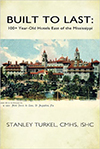
Built to Last: 100+ Year-Old Hotels East of the Mississippi is available for purchase from the publisher by visiting bookstore.authorhouse.com.























